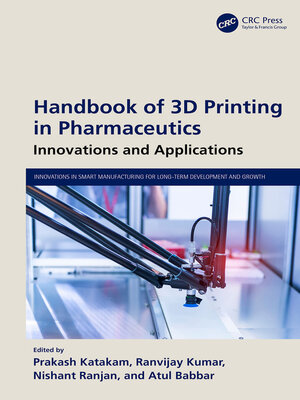Handbook of 3D Printing in Pharmaceutics
ebook ∣ Innovations and Applications · Innovations in Smart Manufacturing for Long-Term Development and Growth
By Prakash Katakam

Sign up to save your library
With an OverDrive account, you can save your favorite libraries for at-a-glance information about availability. Find out more about OverDrive accounts.
Find this title in Libby, the library reading app by OverDrive.



Search for a digital library with this title
Title found at these libraries:
| Library Name | Distance |
|---|---|
| Loading... |
Three-dimensional (3D) printing has evolved as an emerging tool for the design of customized or personalized medication that provides the maximum therapeutic benefits to patients. The manufacturing of medicines in small batches customized with tailored dosages, sizes, shapes, and drug release properties is the key prospect of using 3D printing in pharmaceutics.
Handbook of 3D Printing in Pharmaceutics: Innovations and Applications provides a detailed and in-depth technical discussion on the various additive manufacturing processes for the development of pharmaceutical products with experimental justification. It details the characterization, optimization, and numerical modeling of the processes involved and outlines the industrial implications of the resulting products as well as offering solutions for patient- tailored drugs processed by additive manufacturing. The handbook goes on to focus on the various post- processing technologies available to fortify the mechanical, chemical, biological, geometrical, and other characteristics of additively manufactured components and also discusses future directions and possible research gaps that need to be filled.
The buyers of this cutting-edge handbook will learn the complete information and methodology for manufacturing drug delivery systems and customized medicine for biomedical applications. It is an ideal read for undergraduates, graduates, and postgraduate research scholars. Industrial and academic professionals working and studying industrial, manufacturing, and production engineering, along with those studying mechanical engineering, pharmaceutical sciences, material science, chemical engineering, biomedical engineering, automobile/aerospace engineering, and other relevant domains will want this handbook at their fingertips.







